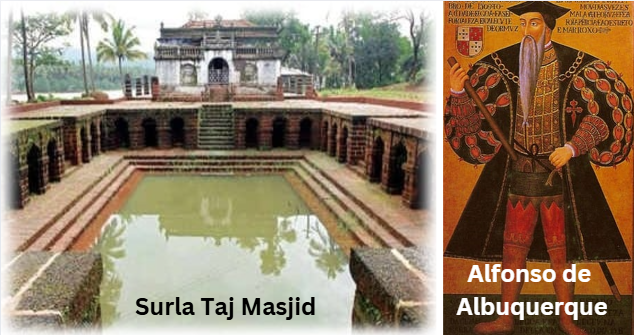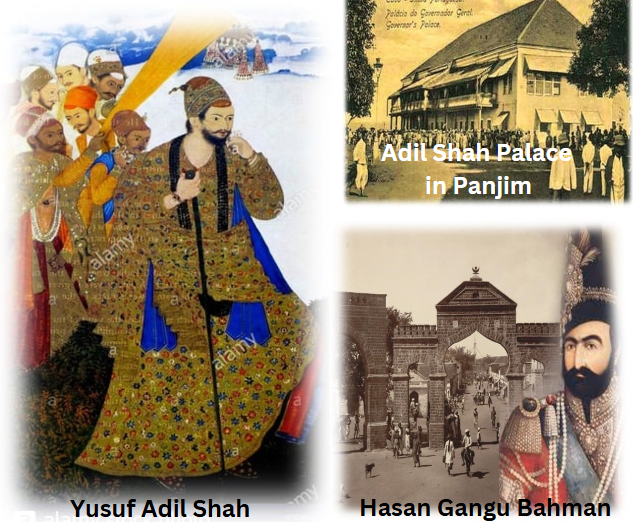– Nazrana Darvesh
Panjim
This article is a small effort to foster peace in the present environment of hate and communal discord within the state.
Goa has been ruled by many different dynasties over the centuries, each contributing to its rich history. It was first ruled by the Shilaharas from the 8th to the 10th century, followed by the Kadambas from 1006 to 1356. In the 12th and 13th centuries, the Yadavas of Devgiri took control, and in the 14th and 15th centuries, Goa became part of the Vijayanagara Empire. The Bahmani Sultanate ruled in the 15th century, followed by the Adilshahi dynasty from 1498 to 1510. In 1510, the Portuguese took control of Goa, ruling until 1961.
A key part of Goa’s unique identity is its long history of communal harmony, where people of different religions and ethnic backgrounds lived peacefully together. Muslims first came to Goa in the 8th century, when Arab traders established trades in places like Pillar and Goa Velha.
 They had friendly relations with local rulers. One story tells of an Arab trader, Mahmud, who helped the Kadamba king Guhalladeva-I after his ship had broken apart while going for pilgrimage to Somnath temple. Mahmud’s son, Saddam, was appointed Chief Minister by King Jaykeshi-I and was given the village of Merces. Saddam established social institution at Goa Velha known as ‘House of Poor’ which provided food and solved problems of poverty and unemployment.
They had friendly relations with local rulers. One story tells of an Arab trader, Mahmud, who helped the Kadamba king Guhalladeva-I after his ship had broken apart while going for pilgrimage to Somnath temple. Mahmud’s son, Saddam, was appointed Chief Minister by King Jaykeshi-I and was given the village of Merces. Saddam established social institution at Goa Velha known as ‘House of Poor’ which provided food and solved problems of poverty and unemployment.
Another interesting chapter is from the 14th century, when Hasan Gangu Bahman – Sultan Hasan of the Bahmani Sultanate ruled Goa. He earned the title “Hasan Gangu Bahman” due to his friendship with Gangu who was Brahmin and admired the Sultan’s honesty. It was the result of this friendship that the Sultan named his kingdom the Bahmani Kingdom.
Yusuf Adil Shah ruled Goa from 1498 to 1510. Born a Turk, he was brought to India and sold as a slave to Mahmud Gawan, the prime minister of the Bahmani kingdom, in Bidar.
Adil Shah was 55 when he took control of Goa. When Goa came under Adil Shah’s rule, he continued the reforms initiated by Mahmud Gawan, the Bahmani prime minister. His reign covered Tiswadi, Bardez, Salcette, Pednem, Sanklim, Bicholim, Ponda, Sattari, Sanguem, Quepem, and Canacona. While the Portuguese captured Tiwadi in 1510, Bardez, Salcette, and Mormugao remained under Adil Shah until 1543. Ponda, Pednem, Bicholim, and Sattari stayed under his rule from the late 15th to mid-17th century.
Adil Shah was one of the most tolerant Muslim rulers of his time, akin to Akbar. Taleigao had three temples, which Adil Shah allowed to function freely. These temples were later destroyed by the Portuguese. When the Portuguese began their temple demolitions, Hindus moved their deities to Adil Shah’s territories in Ponda, where he provided protection and allowed these temples to flourish. As a result, many of Ponda’s temples were relocated there.
Revenue collection was carried out by Hindu officers with titles like Desai. Sardesai was very prestigious title acquired by some families in Goa given by Adil shah. The Desh Prabhus, Desais of Pednem, and Langao Desai of Bicholim became part of the ruling elite under his reign. He also gave the Sardesai title to some Ranes of Sattari. Adil Shah also introduced the jagirdari system in Goa and ensured religious freedom for Hindus, offering them high positions without interference in their religious practices. The Narasimha temple within Bijapur’s Adil Shahi fort stands as a lasting example of this communal harmony.
In Pednem, there is a famous song, “Bhalega Desai Watandar Agarwado Gaon Tuka Mokaso Dila,” which refers to the Parshem village granted to the Prabhu Parsekar Desai family by Adil Shah. The political unification we see today was achieved under his rule.
Adil Shah’s heritage includes landmarks such as the Adil Shah Palace in Panaji, the Safa Masjid in Ponda, Surla Taj Masjid in Bicholim, Banastarim Fort (originally a military watchtower), and the fortification wall at Old Goa. Other notable sites include the remains of his palace at Old Goa, the Mazaars of Pirs in Ponda and Bicholim, and remnants of the Zenanakhana (harem) in Panaji. The Adil Shahi Mosque in Old Goa has been destroyed, and the area to the left of the road from Panaji to Old Goa was once used for weapon storage and manufacturing under Adil Shah, later converted into a shipyard by the Portuguese. Additionally, there was a gunpowder factory in Old Goa established by Adil Shah.
Goan markets hosted seasonal fairs where villagers sold surplus agricultural and craft products in exchange for needed provisions. Merchants traded goods like gold, silver, pepper, spices, cotton cloth, and perfumes. Industries that flourished included spinning, weaving, brass and bronze work, carpentry, jewellery-making, iron goods, basket-making, oil-making, and pottery. The coexistence between Hindus and Muslims was generally peaceful. Hindus and Muslims worked side by side in trade, administration, and various occupations, and there was a blending of cultural practices.
The folk song “Shabaichi Bavli Tari Kade Pavli Shabai” is sung in memory of Adil Shah, with “Shabai” referring to his defeat by the Portuguese.
In 1510, Alfonso de Albuquerque laid siege to Goa and entered the city on February 17 with little resistance, as Adil Shah was preoccupied with other forces. However, Adil Shah soon retaliated, and by May 23, Albuquerque was forced to flee.
During Alfonso de Albuquerque’s first failed attack on Goa, his fleet was stranded at the mouth of the harbour for nearly three months due to weather, suffering from starvation and sickness. When Yusuf Adil Shah came to know of this, that monarch, with true chivalry, offered to send provisions to the Portuguese, stating that he wished to conquer them not by starvation but by the sword.
Albuquerque made a second attempt on November 25, 1510, just days after Adil Shah’s death. With the heir, the infant Ismail Adil Shah, and Goa under the command of General Rasul Khan, Albuquerque seized the opportunity. After a brief but bloody battle, he successfully captured the city of Ela on St. Catherine’s Day, November 25, 1510.
Thus, Tiswadi Taluka fell under Portuguese rule. Timoja was appointed as the Portuguese Thanedar. By 1543, the Portuguese had extended their control over Salcette, Mormugao, and Bardez, completing the first phase of their expansion into Goa.
[Abstract from book ‘Muslim History and Heritage of Goa’ by Prajal Sakhardande
‘Snapshots of Indo-Portuguese History’ by Vasco Pinho]




